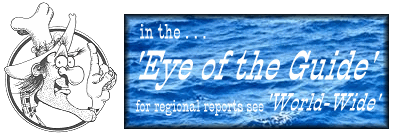|
The rainbows in such situations always pose a challenge to my anglers.
There are problems with getting an accurate cast into an area the size of a
kitchen sink. There are problems with getting a drag free float,
especially since the fish is resting in calm water and just taking insects
off the inside edge of the feed line. The proper pattern, the proper
approach and stalk add further complications to this pulse raising game of
life and death (the fish doesn't know that he or she will be put
back--anytime a fish is hooked, the fish is literally fighting for its
life).
Yes, summer time is not the time to leave the Bighorn River for so much is
happening. In my estimation the best fly hatches occur during the months
of July and August. In early July the yellow sallies ( a small, yellow
stonefly) start hatching on the lower river. Simultaneously, the pale
morning duns appear. Toward the end of July, the black caddis appear in
phenomenal numbers. In mid August the sedge caddis start and, by the end
of the month, the tricos appear.

The yellow sally is a size 14 (plus or minus a size) stonefly that
inhabits the riffles and runs of the Bighorn. It hatches mid day--a real
break for lazy anglers and guides--usually in fairly shallow water. The
trout will move into these waters and go after the emerging and adult
stoneflies with a vengeance. As the adult stoneflies are skittering across
the surface trying to get airborne, the trout take them dramatically.
Toilet flushes, a ten pound bag of sugar dropped into the water, and a
grasshopper take are comparable analogies.
 Probably the best dry fly fishing for yellow sallies comes later in the
day as the trout cruise looking for the crippled and spent sallies. The
rises will be very sporadic, but if you can get a cast close to the rise
within five seconds or so, you stand a relatively good chance of hooking a
trout.
Probably the best dry fly fishing for yellow sallies comes later in the
day as the trout cruise looking for the crippled and spent sallies. The
rises will be very sporadic, but if you can get a cast close to the rise
within five seconds or so, you stand a relatively good chance of hooking a
trout.

I find that about any yellow sally pattern will get the job done, but I
prefer a size 14 thorax tie. I dub on some red rabbit for a tag or butt,
then dub some light yellow on to cover about 2/3 the shank. Then I add a
sparse wing of bleached elk hair, measured to be no more than the length of
the hook. I tie in a light ginger hackle, get eight or so wraps, tie it
off and clip it. Then I spin on some more yellow dubbing and wrap it.
When I start to take the dubbing under the hook, I bring the dubbing back
behind the hackle, lift up the hackle with the dubbing, go over the top of
the hook behind the hackle and when I start to go under, come forward. I
repeat the previous two steps. In this way I have created an "X" with the
dubbing under the fly and lifted up the hackle so that the fly sits flat on
the water.
|









